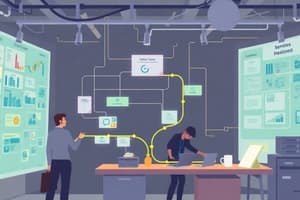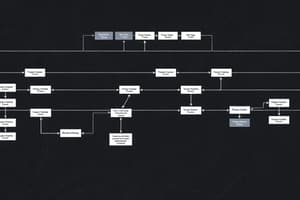Podcast
Questions and Answers
What is the primary purpose of process mapping?
What is the primary purpose of process mapping?
- To forecast future sales.
- To understand and analyze workflows. (correct)
- To create visual art.
- To document employee attendance.
Which symbol in process mapping represents a decision point?
Which symbol in process mapping represents a decision point?
- Diamond (correct)
- Parallelogram
- Oval
- Rectangle
Which of the following describes a Value-Adding (VA) activity?
Which of the following describes a Value-Adding (VA) activity?
- Storing excess inventory for future sales.
- Manufacturing a product that meets customer needs. (correct)
- Waiting for approval on an order.
- Quality inspections that are mandatory.
What does the term NNVA stand for in process mapping?
What does the term NNVA stand for in process mapping?
What is one of the primary goals of identifying inefficiencies in a process?
What is one of the primary goals of identifying inefficiencies in a process?
Which lean waste is represented by the 'I' in TIMWOOD?
Which lean waste is represented by the 'I' in TIMWOOD?
Which symbol is used to indicate the start or end of a process?
Which symbol is used to indicate the start or end of a process?
Which of the following best describes Non-Value-Adding (NVA) activities?
Which of the following best describes Non-Value-Adding (NVA) activities?
What is the first step in creating a Cause and Effect diagram?
What is the first step in creating a Cause and Effect diagram?
Which of the following is NOT considered a main category in the Cause and Effect diagram?
Which of the following is NOT considered a main category in the Cause and Effect diagram?
In the context of the Cause and Effect diagram, which sub-cause would be categorized under 'Methods'?
In the context of the Cause and Effect diagram, which sub-cause would be categorized under 'Methods'?
What is the purpose of using data or tools like Pareto charts when analyzing causes?
What is the purpose of using data or tools like Pareto charts when analyzing causes?
Which of the following sub-causes relates to the 'Machines' category?
Which of the following sub-causes relates to the 'Machines' category?
How does a Cause and Effect diagram visually represent its elements?
How does a Cause and Effect diagram visually represent its elements?
Which statement reflects a common issue identified under the 'Environment' category?
Which statement reflects a common issue identified under the 'Environment' category?
What is a potential drawback of having inadequate monitoring systems in relation to 'Measurements'?
What is a potential drawback of having inadequate monitoring systems in relation to 'Measurements'?
What is considered the most important type of waste in a production process?
What is considered the most important type of waste in a production process?
Which type of waste involves unnecessary movement of people or equipment?
Which type of waste involves unnecessary movement of people or equipment?
Which primary question focuses on the necessity of a process step?
Which primary question focuses on the necessity of a process step?
What characterizes overprocessing in a production context?
What characterizes overprocessing in a production context?
Which question would best address potential delays in a work process?
Which question would best address potential delays in a work process?
What is the relationship between defects and customer satisfaction?
What is the relationship between defects and customer satisfaction?
Which of the following waste types encompasses idle time caused by delays?
Which of the following waste types encompasses idle time caused by delays?
Which of these is not a primary question useful for process improvement?
Which of these is not a primary question useful for process improvement?
What characterizes reinforcing loops in causal loop diagrams?
What characterizes reinforcing loops in causal loop diagrams?
In a causal loop diagram, what does a positive polarity indicate?
In a causal loop diagram, what does a positive polarity indicate?
Which example best illustrates goal-seeking behavior in a balancing loop?
Which example best illustrates goal-seeking behavior in a balancing loop?
What is one necessary condition for exponential growth in causal loops?
What is one necessary condition for exponential growth in causal loops?
What do delays in feedback in causal loop diagrams typically cause?
What do delays in feedback in causal loop diagrams typically cause?
Which of the following best describes balancing loops?
Which of the following best describes balancing loops?
In causal loop diagrams, how are variables represented?
In causal loop diagrams, how are variables represented?
What is indicated by arrows in a causal loop diagram?
What is indicated by arrows in a causal loop diagram?
What is the primary purpose of a Cause and Effect (Ishikawa) diagram?
What is the primary purpose of a Cause and Effect (Ishikawa) diagram?
In the structure of a Cause and Effect diagram, what does the 'head' represent?
In the structure of a Cause and Effect diagram, what does the 'head' represent?
Which of the following is NOT a main category typically represented in a Cause and Effect diagram?
Which of the following is NOT a main category typically represented in a Cause and Effect diagram?
What is one of the first steps in generating a Cause and Effect diagram?
What is one of the first steps in generating a Cause and Effect diagram?
Which of the following best describes the 'spine' of a Cause and Effect diagram?
Which of the following best describes the 'spine' of a Cause and Effect diagram?
Which component of a Cause and Effect diagram consists of specific causes that fall under main categories?
Which component of a Cause and Effect diagram consists of specific causes that fall under main categories?
Which industry commonly utilizes Cause and Effect diagrams as part of their quality control processes?
Which industry commonly utilizes Cause and Effect diagrams as part of their quality control processes?
What role do arrows play in a Cause and Effect diagram?
What role do arrows play in a Cause and Effect diagram?
What primarily drives initial growth in S-shaped growth patterns?
What primarily drives initial growth in S-shaped growth patterns?
What is a necessary condition for S-shaped growth to occur?
What is a necessary condition for S-shaped growth to occur?
Which loop is characterized by conditions worsening over time, such as deforestation leading to poorer air quality?
Which loop is characterized by conditions worsening over time, such as deforestation leading to poorer air quality?
Which of the following is essential for creating a causal loop diagram?
Which of the following is essential for creating a causal loop diagram?
What type of behavior requires at least one negative feedback loop aimed at correcting deviations?
What type of behavior requires at least one negative feedback loop aimed at correcting deviations?
Which factor is NOT mentioned as a variable influencing air quality?
Which factor is NOT mentioned as a variable influencing air quality?
In the context of feedback loops, which scenario would create oscillations?
In the context of feedback loops, which scenario would create oscillations?
Which of the following is NOT a step in creating a causal loop diagram?
Which of the following is NOT a step in creating a causal loop diagram?
Flashcards
Process Mapping
Process Mapping
A visual representation of the steps involved in a process, used to analyze workflows, identify inefficiencies, and improve procedures.
Oval (Terminator)
Oval (Terminator)
Represents the start or end point of a process.
Rectangle (Process/Activity)
Rectangle (Process/Activity)
Represents a task or activity performed in the process.
Diamond (Decision)
Diamond (Decision)
Signup and view all the flashcards
Arrow (Flowline)
Arrow (Flowline)
Signup and view all the flashcards
Parallelogram (Input/Output)
Parallelogram (Input/Output)
Signup and view all the flashcards
Value-Adding Activities (VA)
Value-Adding Activities (VA)
Signup and view all the flashcards
Non-Value-Adding Activities (NVA)
Non-Value-Adding Activities (NVA)
Signup and view all the flashcards
Transportation Waste
Transportation Waste
Signup and view all the flashcards
Inventory Waste
Inventory Waste
Signup and view all the flashcards
Motion Waste
Motion Waste
Signup and view all the flashcards
Waiting Waste
Waiting Waste
Signup and view all the flashcards
Overproduction Waste
Overproduction Waste
Signup and view all the flashcards
Overprocessing Waste
Overprocessing Waste
Signup and view all the flashcards
Defects Waste
Defects Waste
Signup and view all the flashcards
Non-Value-Adding Activities
Non-Value-Adding Activities
Signup and view all the flashcards
Cause and Effect Diagram
Cause and Effect Diagram
Signup and view all the flashcards
Effect
Effect
Signup and view all the flashcards
Main Categories
Main Categories
Signup and view all the flashcards
Sub-Causes
Sub-Causes
Signup and view all the flashcards
Arrows
Arrows
Signup and view all the flashcards
Define the Problem
Define the Problem
Signup and view all the flashcards
Assemble a Team
Assemble a Team
Signup and view all the flashcards
Identify Main Categories
Identify Main Categories
Signup and view all the flashcards
Cause and Effect Diagram (Fishbone Diagram)
Cause and Effect Diagram (Fishbone Diagram)
Signup and view all the flashcards
Main Categories (Bones)
Main Categories (Bones)
Signup and view all the flashcards
Effect (Head)
Effect (Head)
Signup and view all the flashcards
Root Causes
Root Causes
Signup and view all the flashcards
Cause and Effect Analysis
Cause and Effect Analysis
Signup and view all the flashcards
Pareto Chart
Pareto Chart
Signup and view all the flashcards
Causal Loop Diagram (CLD)
Causal Loop Diagram (CLD)
Signup and view all the flashcards
Reinforcing Loops (R)
Reinforcing Loops (R)
Signup and view all the flashcards
Balancing Loops (B)
Balancing Loops (B)
Signup and view all the flashcards
Negative Polarity (-)
Negative Polarity (-)
Signup and view all the flashcards
Positive Polarity (+)
Positive Polarity (+)
Signup and view all the flashcards
Delays
Delays
Signup and view all the flashcards
Exponential Growth (Reinforcing Loop)
Exponential Growth (Reinforcing Loop)
Signup and view all the flashcards
Goal-Seeking Behavior (Balancing Loop)
Goal-Seeking Behavior (Balancing Loop)
Signup and view all the flashcards
Oscillations (Combined Reinforcing and Balancing Loops with Delays)
Oscillations (Combined Reinforcing and Balancing Loops with Delays)
Signup and view all the flashcards
S-Shaped Growth
S-Shaped Growth
Signup and view all the flashcards
Reinforcing Loops
Reinforcing Loops
Signup and view all the flashcards
Balancing Loops
Balancing Loops
Signup and view all the flashcards
Causal Loop Diagram
Causal Loop Diagram
Signup and view all the flashcards
Identify Variables
Identify Variables
Signup and view all the flashcards
Establish Relationships
Establish Relationships
Signup and view all the flashcards
Identify Feedback Loops
Identify Feedback Loops
Signup and view all the flashcards
Study Notes
Process Mapping
- Process mapping visually represents steps in a process
- Purpose: Understand workflow, identify inefficiencies, standardize procedures, pinpoint bottlenecks, and support continuous improvement initiatives by distinguishing value-adding and non-value-adding activities
Process Mapping Symbols
- Oval (Terminator): Represents start or end of a process
- Rectangle (Process/Activity): Represents a task or activity
- Diamond (Decision): Represents a decision point (yes/no or conditional path)
- Arrow (Flowline): Indicates process flow direction between steps
- Parallelogram (Input/Output): Represents data or materials entering or leaving the process
VA, NVA, and NNVA Activities
- VA (Value-Adding Activities): Directly create value for the customer
- NVA (Non-Value-Adding Activities): Consume resources without adding customer value
- NNVA (Necessary Non-Value-Adding Activities): Necessary due to legal, regulatory, or business requirements, but do not directly add value
Lean Wastes (TIMWOOD)
- Transportation: Unnecessary movement of materials/products
- Inventory: Excess raw materials, WIP, or finished goods
- Motion: Unnecessary movement of people/equipment
- Waiting: Idle time due to delays in the process
- Overproduction: Producing more than required or too early
- Overprocessing: Performing unnecessary work or adding features that don't add value
- Defects: Production of defective items requiring rework/scrapping
Primary Questions for Process Improvement
- Is this step essential to the process?
- Does this activity add value for the customer?
- Can this activity be eliminated?
- Can this activity be automated or streamlined?
- Is there any redundancy in this step?
- Are there delays associated with this step?
- Does this step require rework or corrections?
- Can the layout or flow of this step be improved?
- Is the correct amount of resources allocated here?
- Can this activity be performed faster or more efficiently?
Secondary Questions for Process Improvement
- Who performs this step, and are they the right person/team?
- Are the tools used in this step appropriate and effective?
- Is this step prone to errors or defects?
- Is there a way to simplify this activity?
- Can this step be consolidated with another?
- Is there a clear understanding of why this step exists?
- Are there any bottlenecks related to this activity?
- Can technology be introduced to improve this step?
- How often does this step occur, and is it aligned with demand?
- Does this step comply with all necessary regulations and standards?
Cause and Effect Diagram (Ishikawa/Fishbone Diagram)
- Used to identify, analyze, and visualize potential causes of a problem/effect
- Breaks down root causes into smaller, manageable parts
- Facilitates brainstorming and collaborative problem-solving
- Aids in quality control and continuous improvement
Cause and Effect Diagram Structure
- Effect (Head): Represents the problem or issue
- Main Categories (Bones): Broad areas where causes may originate (People, Methods, Machines, Materials, Environment, Measurements)
- Sub-Causes (Smaller Bones): Specific causes falling under main categories
- Arrows: Connect each cause to its category and the central spine, visually displaying cause-effect relationships
Creating a Cause and Effect Diagram
- Define the problem
- Assemble a team
- Identify main categories
- Brainstorm sub-causes
- Construct the diagram by drawing the "spine" and adding branches for main categories and sub-causes
- Analyze and prioritize causes
Causal Loop Diagrams (CLDs)
- Visual tools for modeling and analyzing feedback loops and interdependencies within dynamic systems
- Used to identify how variables interact over time, creating feedback dynamics
Causal Loop Diagram Purpose
- Visualize and understand feedback structure of a system
- Identify dynamic behaviors (growth, decay, oscillations, stabilization)
- Provide insights for intervention or improvement
Causal Loop Diagram Principles
- Feedback Loops: Reinforcing (amplifies change), Balancing (counteracts change)
- Variables and Arrows: Variables represent system elements, arrows indicate causal relationships between variables
- Polarity: Positive (+) change in one variable causes corresponding change in another, Negative (-) change in one variable causes opposite change in another
- Delays: Time delays within feedback can significantly impact system behavior
Studying That Suits You
Use AI to generate personalized quizzes and flashcards to suit your learning preferences.
Related Documents
Description
Test your knowledge of process mapping and lean principles with this insightful quiz. Explore key concepts such as Value-Adding activities, decision points in process mapping, and the use of Cause and Effect diagrams. Perfect for those looking to enhance their understanding of process improvement techniques.




